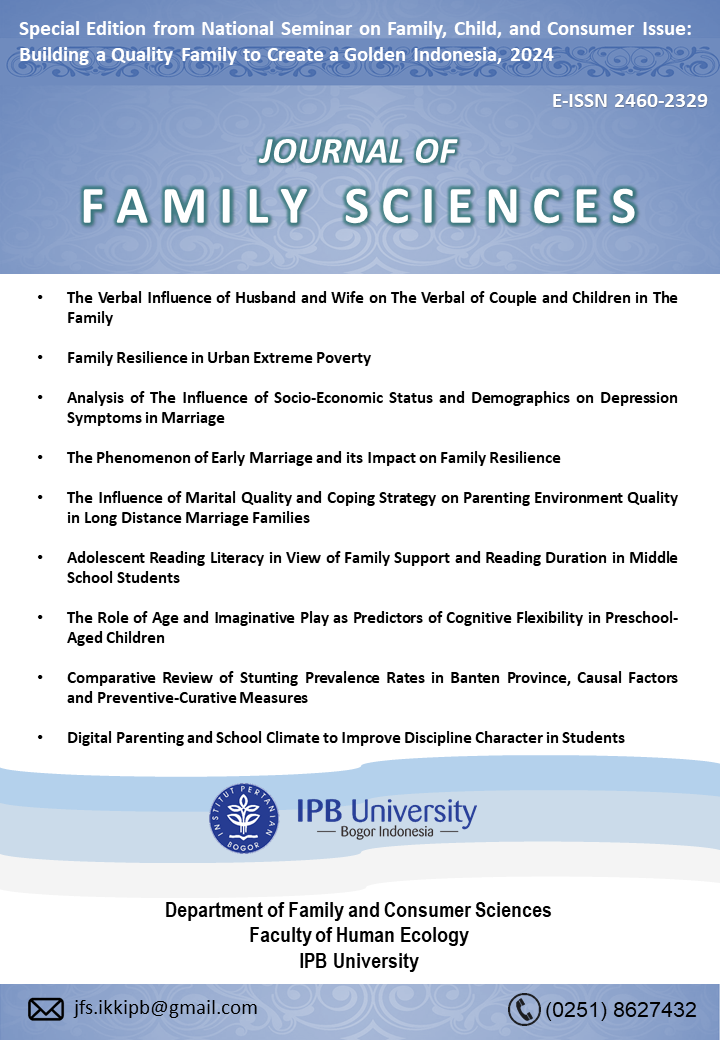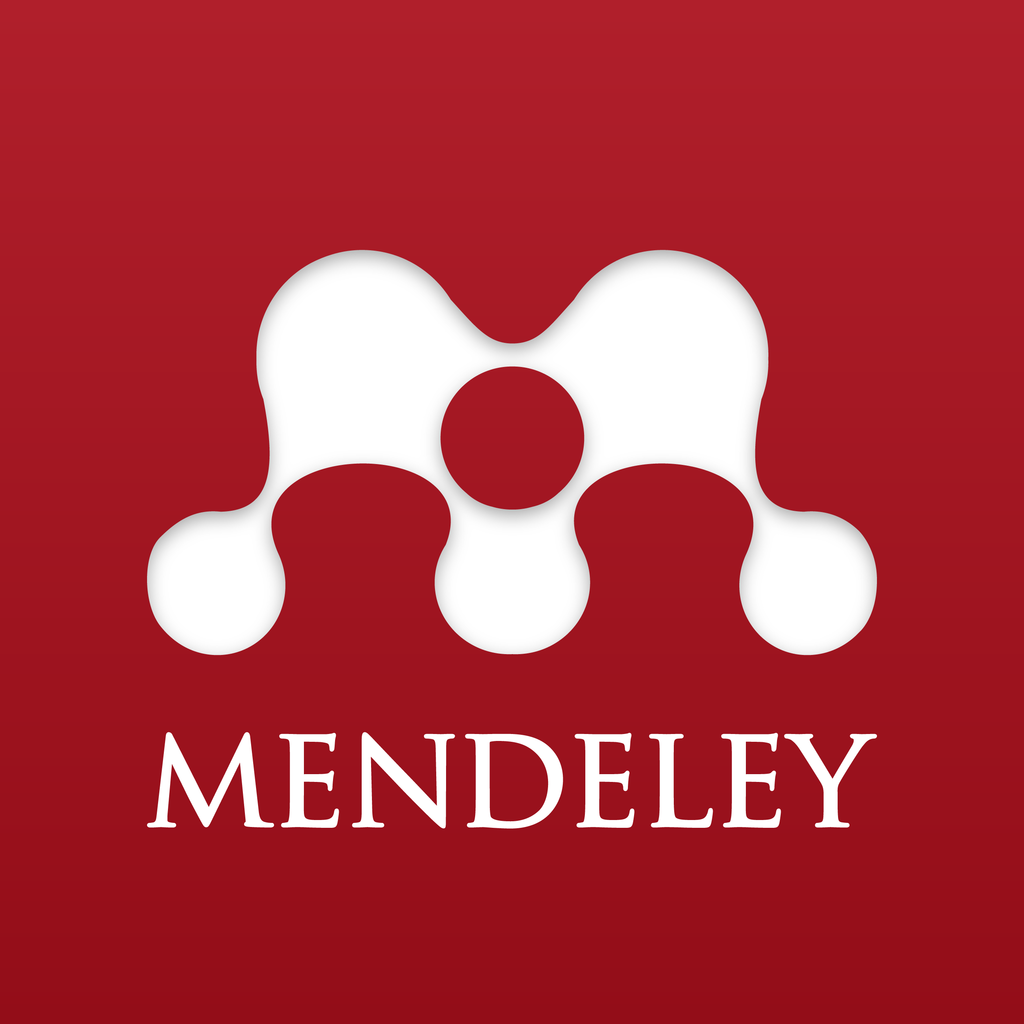Adolescent Reading Literacy in View of Family Support and Reading Duration in Middle School Students
Abstract
Literacy is an important skill and relates to the ability to listen, speak, write, and count. This study aims to analyze the influence of family support and duration of reading on adolescent reading literacy. This study uses a quantitative survey approach research design. The number of samples in this study were 127 students through cluster random sampling method. Data analysis was carried out in several stages, namely data coding, SPSS analysis, namely inference test, normality test, correlation test, and multiple linear regression test. The results showed that the dominant (36.2%) subjects were 14 years old. As many as (30.7%) are 15 years old. The results showed that half (50%) of the research subjects read books for entertainment several times a year. The results showed that the majority (68%) of the study subjects had moderate reading duration and the family support given to the sample was very high (93%). The results of the study also show that family support and duration of reading affect adolescent reading literacy. The result of this study have implications for parent mindset to support literacy from an early age and adolescent to read more frequently.
Downloads
References
Aprilianto, E., Lumadi, S. A., & Handian, F. I. (2021). Familiy social support and the self-esteem of breast cancer patients undergoing neoadjuvant chemotherapy. Journal of Public Health Research, 10(2), 2234. http://doi.org/10.4081/jphr.2021.2234
Atmazaki, Ali, N. B. V., Muldian, W., Miftahussururi, Nento, M. N., & Akbari, Q. S. (2017). Guide to The National Literacy Movement. Ministry of Education and Culture.
Azwar, S. (2017). Preparation of a psychological scale. Student Library
Cahya, W. D., Padmadewi, N. N., Artini, L. P. (2020). The implementation of independent reading literacy in secondary education. Journal of Educational Research and Evulation, 4(1) 63-72. https://doi.org/10.23887/jere.v4i1.23515
Cox, D. (2006). The Edwin friedman model of family system thinking. Academic Leadership: The Online Journal, 4(4), 10. http://doi.org/10.58809/MBQW7762
Donahue, P. L., Voelkl, K. E., Campbell, J. R., & Mazzeo, J. (1998). NAEP 1996 trends in academic progress. Washington, DC: US Department of Education.
Esmaeeli, S. (2023). A model of the home literacy environment and family risk of reading difficulty in relation to children’s preschool emergent literacy. Journal of Learning Disability, 1-16. https://doi.org/10.1177/00222194231195623
Ettekal, A. V., & Mahoney, J. L. (2017). The SAGE encyclopedia of out-of-school learning. Ecological Systems Theory, 230-241. http://dx.doi.org/10.4135/9781483385198.n94
Fauziyah, D. F., Sunendar, D., & Damaianti, V. S. (2020). Strategies for family literacy education through diktatic analysis of stories by litara children. Scientific Journal of Language Education, Indonesian and Regional Literature, 10(2), 61-70. https://doi.org/10.23969/literasi.v10i2.2800
Flisi, S., Goglio V., Meroni E.C.,Vera-Toscano, & Esperanza. (2019). Cohort patterns in adults literacy skills: how are new generation doing?. Journal of Policy Modeling, 41, 52-65. https://doi.org/10.1016/j.jpolmod.2018.10.002
Friedman, M. M. (1998). Keperawatan Keluarga : Teori dan Praktik. Jakarta (ID): EGC.
Hermawati, N. S., & Sugito. (2022). The role of parents in providing home literacy environment (hle) in early childhood. Journal Obsession: Journal Early Childhood Education, 6(3), 1367-1381. https://doi.org/10.31004/obsesi.v6i3.1706
Hindin, A., & Paratore, J. R. (2007). Supporting young children’s literacy learning through home-school partnerships: the effectivness of a home repeated-reading intervention. Journal of Literacy Research, 39(3), 307-333. https://doi.org/10.1080/10862960701613102
Hurlock, B. E. (1980). Development Psychology a Life-Span Approach, Fifth Edition. New York (US): McGraw-Hill
Husain, F. M., Choo, J. C. S., & Singh, M. K. M. (2011). Malaysian mother’s belief in developing emergent literacy through reading. Procedia- Social and Behavioral Sciences, 29, 846-855. https://doi.org/10.1016/j.sbspro.2011.11.313
Kardenis, A., & Can R. (2014). A research on book reading habits and media literacy of student at faculty of education. Procedia Social and Behavioral Sciences. 174, 4058-4067. https://doi.org/10.1016/j.sbspro.2015.01.1155
Locher, F., & Pfost, M. (2020). The relation between time spent reading and reading comprehension throughout the life course. Journal of Research in Reading, 43(1), 57-77. https://doi.org/10.1111/1467-9817.12289
Muslimin. (2018). Fostering a culture of literacy through increasing interest in reading in the village community. Educational Horizon, 37(1), 107-118. Retrieved from https://journal.uny.ac.id/index.php/cp/article/viewFile/17141/pdf
Ningsih, A.W., Shara, A. M., Andirani, D., & Kisno. (2021). Reading duration and financial literacy in vocational school. Jurnal Education and Development, 9(1), 577-583. https://doi.org/10.37081/ed.v9i1.2288
Noor, N. M. (2011). Reading habits and preferences of efl post graduates : a case study. Indonesian Journal of Applied Lingusitic, 1(1), 1-9.
Parsetyowati, I., Setyari, A. D., Eriyanti, L. D., & Rohman, H. (2022). Penambangan village assistance towards women, children and cultural friendly inclusion villages. Bhakti Communty Journal, 1(2), 112-121. https://doi.org/10.36376/bcj.v1i2.14
Rahesi, I. D., Abidin, Y., & Mulyati, Y. (2019). The interaction of the model of reading aloud with children's story books in fostering family literacy. in: Proceeding UPI XIII International Language Research Seminar 2019. 1289-1296.
Rahmadanita, A. (2022). Low adolescent literacy in indonesia: problems and solutions. Scientific Library Journal, 8(2), 55-62. https://dx.doi.org/10.20961/jpi.v8i2.66437.
Salsabila, H. U. (2018). Bronfenbrenner's ecological theory as an approach in the development of an Islamic religious education curriculum. Journal of Islamic Communication and Education, 7(1), 139-158. Retrieved from https://journal.staimsyk.ac.id/index.php/almanar/article/view/72/69
Samsudi, M. (2021). Regional Literacy Movement, Raise Interest in Reading in the Bondowoso Community. Retrieved from https://bondowosokab.go.id/index.php/berita/melalui-talk-show-pemkab-bondowoso-galakkan-literasi-daerah
Shara, A. M., Andriani, D., & Ningsih, A. W. (2020). Correlating reading literacy and writting literacy in junior high school pematangsiantar. Journal of English Education (JEE), 5(2), 72-85. http://dx.doi.org/10.31327/jee.v5i2.1249.
Tong, F., Zhang, H., Zhen, F., Irby, B. J., Lara-Alecio, R. (2021). Supporting home literacy practices in promoting chinese’s parents’ engagement in their children’s english education in low ses families : an experimental study. International Journal of Educational Research, 109, 1- 16. https://doi.org/10.1016/j.ijer.2021.101816
Torppa, M., Vasalampi, K., Eklund, K., & Niemi, P. (2022). Long-term effects of the home literacy environment on reading development; familial risk for dyslexia as mediator. Journal of Experimental Child Psychology, 215, 1-22. http://doi.org/10.1016/j.jecp.2021.105314.
Uusen, A., & Muursepp, M. (2012). Gender differences in reading habits among boys and girls of basics school in Estonia. Procedia – Social and Behavioral Sciences, 69, 1795-1804. https://doi.org/10.1016/j.sbspro.2012.12.129
Vasalampi, K., Tolvanen, A., Torppa, M., Poikkeus, A., Hankimaa, H., & Aunola, K. (2023). PISA reading achievement, literacy motivation, and school burnout predicting Adolescents’ educational track and educational attainment. Learning and Individual Differences. 108, 1-10. https://doi.org/10.1016/j.lindif.2023.102377
Walker, R., Swain, J., & Pellicano E. (2022). “It’s” about sharing moment : “parents’ views and experiences of home reading with their auitistic children with moderate to severe intellectual disabilities. Research in Develpomental Disabilities. 128, 1-14. https://doi.org/10.1016/j.ridd.2022.104289
Wijayanti, S. H. (2020). Indonesian's students reading literacy. Advances in School Science, Education and Humanities Research. 390, 61-65. Retrieved from https://www.atlantis-press.com/proceedings/icracos-19/125931335
Copyright (c) 2024 Journal of Family Sciences

This work is licensed under a Creative Commons Attribution 4.0 International License.
Authors who publish with this journal agree to the following terms:
- Authors retain copyright and grant the journal right of first publication with the work simultaneously licensed under

This work is licensed under a Creative Commons Attribution 4.0 International License. that allows others to share the work with an acknowledgement of the work's authorship and initial publication in this journal. - Authors are able to enter into separate, additional contractual arrangements for the non-exclusive distribution of the journal's published version of the work (e.g., post it to an institutional repository or publish it in a book), with an acknowledgement of its initial publication in this journal.
- Authors are permitted and encouraged to post their work online (e.g., in institutional repositories or on their website) prior to and during the submission process, as it can lead to productive exchanges, as well as earlier and greater citation of published work (See The Effect of Open Access).



_001.png)



